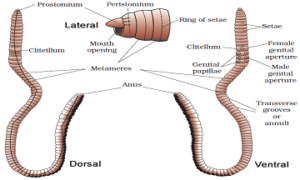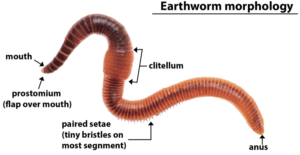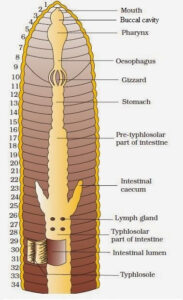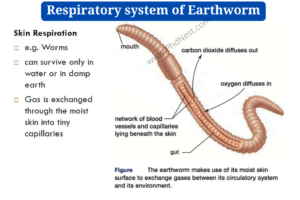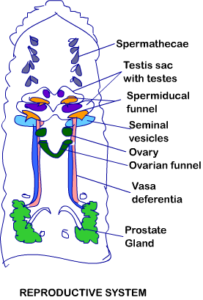What are Seven Organ Systems of the Earthworm ?
Seven Organ Systems of the Earthworm: Earthworms need damp soil to keep their skin moist. Earthworms are simple creatures that pack a powerful environmental punch. They live in moist soil, digging tunnels that aerate the soil for plants and processing vegetation through their digestive systems to turn it into nutrients for the plant roots. Earthworms do all this with basic organ systems.
Earthworms are simple creatures that pack a powerful environmental punch. They live in moist soil, digging tunnels that aerate the soil for plants and processing vegetation through their digestive systems to turn it into nutrients for the plant roots. Earthworms do all this with basic organ systems.
Organ and Organ System –
Morphology – Externally visible feature
Anatomy – Morphology of internal organs
Each organ is made of one or more types of tissue.
Earthworm
- Reddish-brown terrestrial invertebrate.
- The upper layer of moist soil, in burrows by boring/swallowing in day
- Traced by fecal deposits – worm casting
- Pratima & lumbricus.
Morphology of Earthworm
- Long cylindrical body, metamers (similar) about 100-120.in number.
- Dorsal surface – dark median mid dorsal line (blood vessel) along long body.
- Ventral surface – genital opening.
- Anterior end – Mouth & prostomium (covering for the mouth, open force crack in soil into which Earthworm crawl).
- First body segment – Peristomium (contains mouth)
- In the mature worm, segments 14 -16 are covered by dark bland (glandular) – clitellum.
- The body is divisible into prepatellar, clitellar, purlitellar.
- Four pair of spermathecal apertures on ventrolateral side of intersegmental groove – 5th-9thFemale genital pore – midventral line of 14th segment; male- 18th segment
- Minute pores – nephridiopores open on the surface.
- Except first, last, and clitellum, rows of s-shaped setae, embedded in pits of each segment, extended or retracted, locomotion.
Click Here for Complete Biology Notes
Anatomy of Earthworm
- Covered by thin non-cellular cuticle – the epidermis – two muscle layers (circular & long) – innermost coelomic.
- Epidermis – Columnar Epithelial cells (secretory gland cells).
1 . Alimentary canal of Earthworm
- Straight tube between first and last segment.
- The terminal mouth opens into the buccal cavity (1-3 segments), which leads to the pharynx.
- Oesophageal (5-7segments) continue to the gizzard (8-9segment), gliding soil particles & decaying leaves.
- The stomach (9-14) has a calciferous gland that neutralizes humic acid in the humus.
- Intestine (from 15th – last), intestinal caeca (short, conical) on 26th segment.
- Typhlosole – from 26th except for the last 23-25th, internal median fold on a dorsal wall, increases absorption area.
- Opens to the exterior by anus (round)
- The digestive enzyme breaks complex food, a simple molecule is absorbed & utilized.
2. Vascular system of Earthworm
- Closed (blood vessel + capillaries + heart)
- Blood confined to heart & blood vessel.
- Circulation in 1 direction, smaller vessel supply gut, nerve cord, walls.
- Blood gland (4,5,6) – blood cell & hemoglobin in Plasma.
- Blood cells – Phagocytic
3. Respiratory system of Earthworm
- lack breathing devices, moist body surface.
4. Excretory system of Earthworm
- Coiled tubules (nephridia)
- Septal – Both sides of septa of 15 to last (open to the intestine)
- Integumentary – Lining of the body wall of 3rd to last (to the surface)
- Pharyngeal – 3 paired tufts (4th, 5th, 6th)
- Similar in structure, regulate volume & component of fluids.
- Collects fluid from the coelomic chamber, funnel collects & deliver waste through the pore to the body surface.
5. Nervous system of Earthworm
- Ganglia on the ventral side of the paired nerve cord.
- The nerve cord in anterior (3rd & 4th) bifurcates, laterally encircle pharynx, joins cerebral ganglia dorsally to form a ring.
- Cerebral ganglia + other nerves integrate sensory input as well as muscular command response.
6. Sensory system of Earthworm
- No Eyes Possess light (fuel vibrations, light intensity) & tough, sensitive organs.
- Chemoreceptors (taste) – React to stimuli on the anterior part.
7. Reproductive System of Earthworm
- Bisexual
- Testes (2 pairs) – 10th & 11th, vasa differentia run up to 18th to join prostatic.
- Two pairs of accessory glands – 17th & 19th
- Common duct opens to the exterior by male genital pore on the ventrolateral side (18th).
- Four pairs of spermatheca -6th -9th (receive & store sperm during copulation)
- One pair of ovaries on septa of 12th & 13th.
- Ovarian funnel beneath ovary continues to oviduct; join & open on the ventral side as a single median of the genital pore (14th)
- Mate juxtaposing opposite gonads opening exchanging packets of sperm (Spermatophore)
- Mature sperm, egg cells, nutritive fluid deposit in cocoon by gland cell of clitellum. Ova is fertilized within cocoon which slips off worm & deposited in soil. Cocoon holds worm embryo.
- In 3 weeks, 1 cocoon – 2 to 20 baby worms with average of4.
- Direct division (no larva), friends of farmer (makes burrows, soil porous, respiration & Penetration of Division roots, bait in fishing.
- Increase fertility of the soil by worms – vermicomposting
Related Posts
- Phylum Porifera: Classification, Characteristics, Examples
- Dissecting Microscope (Stereo Microscope) Definition, Principle, Uses, Parts
- Epithelial Tissue Vs Connective Tissue: Definition, 16+ Differences, Examples
- 29+ Differences Between Arteries and Veins
- 31+ Differences Between DNA and RNA (DNA vs RNA)
- Eukaryotic Cells: Definition, Parts, Structure, Examples
- Centrifugal Force: Definition, Principle, Formula, Examples
- Asexual Vs Sexual Reproduction: Overview, 18+ Differences, Examples
- Glandular Epithelium: Location, Structure, Functions, Examples
- 25+ Differences between Invertebrates and Vertebrates
- Lineweaver–Burk Plot
- Cilia and Flagella: Definition, Structure, Functions and Diagram
- P-value: Definition, Formula, Table and Calculation
- Nucleosome Model of Chromosome
- Northern Blot: Overview, Principle, Procedure and Results

